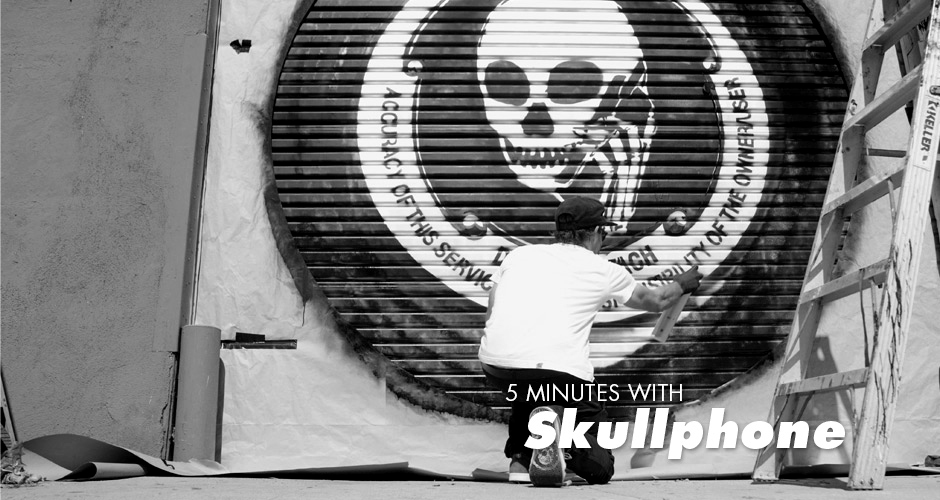Original Post November 6, 2014
Skullphone is a Los Angeles based street artist who burst onto the art scene in the late ’90s. His signature depiction of a black-and-white skull wielding a cellphone popped up in miscellaneous spots around LA, and created a serious buzz. After a brief hiatus, Skullphone reemerged when his work appeared on some of LA’s first digital billboards. His craft continues to address a multitude of socio-cultural issues such as personal privacy, and life in Los Angeles.
In what way has the culture of street art changed since you broke into the scene in the ’90s?
There weren’t widespread street art book sections in stores or libraries back in 2000. It was relatively uncharted territory. And the internet as we know it was only five years old. Flickr and Myspace were online resources, which seems archaic now. The first cop that picked me up in ’99 couldn’t figure out the concept of street art – it wasn’t advertising and it wasn’t traditional graffiti, so he just let me go. That wouldn’t go down like that now. There’s a larger awareness of uncommisioned art now.
You’re an artist whose work is heavily rooted in the streets yet appears in galleries all over the world. What’s your take on the commercialization of street art – more specifically, your own?
I, along with dozens of others worldwide, poured life into the American streets in the late nineties – and we paved a road that other artists sped down later. Early on, it was always a discussion of artists “selling out” by working with companies. It was carefully considered. This is the basis for Shepard Fairey’s sponsorship show in the early 2000s. It’s almost like you’re not making shit happen now if you aren’t crossplatforming between original art pieces and original art products. And I’m all for it. The products are more interesting; and why wait ’til you’re dead and others do it for you? People like to partake in art on so many levels; why hold back on it at that level? This is a discussion that could go on for hours. It’s interesting to consider all the different angles of it still.
Tell us a crazy wheat pasting story.
Oh shit! There’s always a story. Whether working in the rain, dropping tools down the sides of buildings, balancing on water tower beams — the list goes on. I will never look back and wish I’d lived a fuller life. The difference between today and a decade ago is that I better pace myself, allowing less parallax error.
Tell us about your colaboration with Volcom. How did you connect with them and how does their brand vision mesh with your artistic vision?
Volcom has supported my art and art shows for over a decade. In 2012, they produced 2000 Skullphone socks for my XOS|SOX installment at Fuse Gallery in NYC. The socks were stacked in the corner of the gallery, free for patrons to take. The pile was comfy to take naps on (laughs).
Can we expect any collaborations in the near future?
I’m currently working with the artist Sabio from New York. His work is great and we’re in the process of making some collaborative pieces for our upcoming show at New Image Art Gallery in LA.
How do you feel about trends in fashion today?
Recently, I was photographing every person I passed on trains with faded-bleach-pink or grey-blue hair, because it looks rad. When I named the upcoming show Ombre, I did so because of the phoenetic sound, and its definition of ‘faded in color.’ I had no idea it is also the name of this faded hair trend.
What’s next for Skullphone?
A second edition release of hand blown glass ornaments (the first edition was made in 2007). I’m all about these fragile hollow glass things. I still need to choose the colors.
